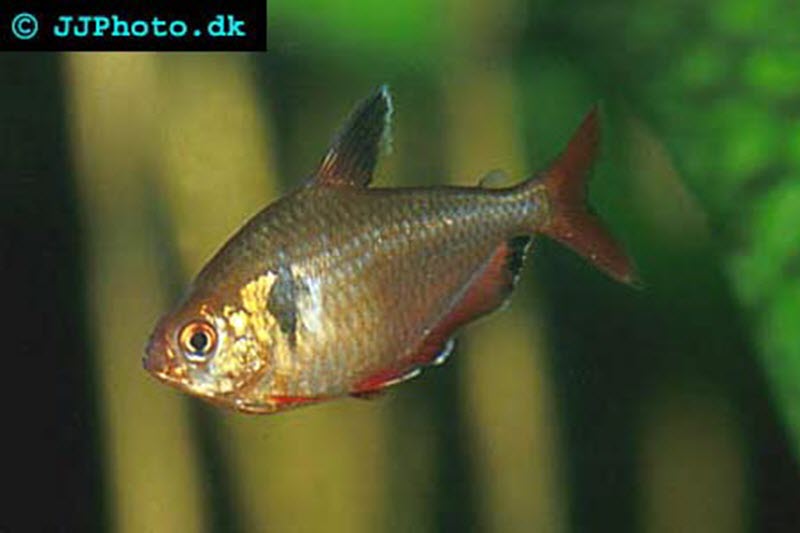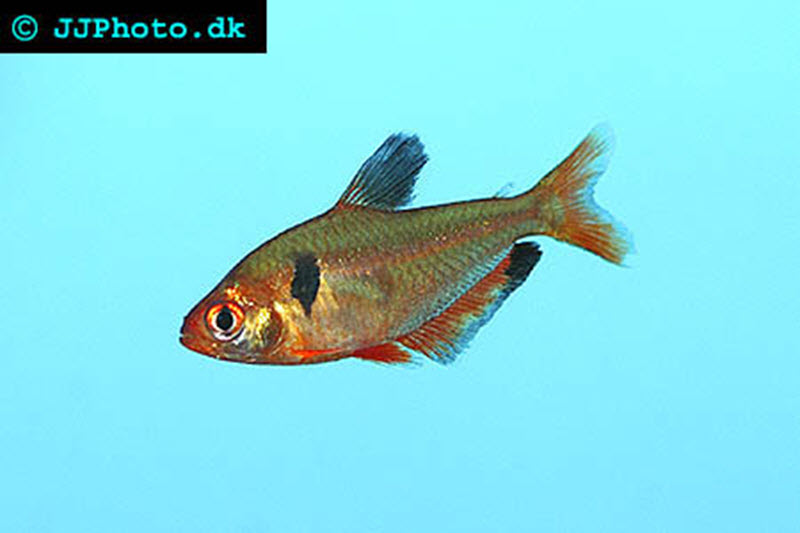Serpae Tetra – Hyphessobrycon serpae
All the different tetra species are small freshwater fishes found in the family Characidae, in the order Characiformes. The Serpae tetra belongs to the genus Hyphessobrycon. Its scientific name is Hyphessobrycon eques, but it is also known as Hyphessobrycon serpae, Hyphessobrycon callistus, and several other names. This abundance of names can of course cause some confusion. Serpae tetra is also commonly referred to as Blood characin, Blood tetra, Callistus tetra, Jewel tetra, Red minor tetra, and Red serpa. “Blood tetras” is a broad term that is used to describe a wide range of red colored tetra hybrids that are sold by fish shops.

Serpae tetra. Copyright www.jjphoto.dk
The body of this tetra is tall and compressed and can reach a size of 1.5 inches (4 centimeters). As mentioned above, this fish is often called things such as “Blood tetra,” “Red minor tetra” and similar, and these names are all derived from the fact that the Serpae tetra has a distinct red body coloration. The shades vary from bright red to reddish brown. The red body is decorated with a black comma-shaped mark that is found right behind the gill cover. Some specimens have a very small marking or have no marking at all. As your Serpae tetra grows older, the marking will grow smaller. The anal fin, ventral fins and tail are all red, and the anal fin is fringed with black and white layers. The dorsal fin of the Serpae Tetra is tall and black, and has a thin white fringe. This fringe can sometimes have a reddish hue.
The Serpae tetra is popular in community aquariums. Keep at least five, preferably, even more, tetras together since they are schooling fishes. They can become a bit aggressive during feeding since they will compete for food and sometimes nip each other’s fins. Some aquarists even compare their feeding habits to the “feeding frenzy” exhibited by piranhas.
It originates from South America where it is found in the Amazon river basin, Guaporé and the Paraguay River. Keep the water temperature in your aquarium between 22 and 26° Celsius (72 and 79° Fahrenheit). The pH should be 5 – 7.8 and the dH 10 – 25. Do not keep your Serpae Tetra in an aquarium that is smaller than 60 centimeters.
The Serpae tetra prefers to stay close to the surface among aquatic plants, and should ideally be kept in a well-planted aquarium. Add some floating plants that will dim the light. Wild tetra is found in calm black waters with densely grown plants.
This tetra feeds on insects, worms, crustaceans, and plants in the wild. They will readily accept most types of food in the aquarium, including flake food and frozen food. Always provide your Serpae tetra with a varied diet to prevent malnutrition.
The Serpae Tetra is one of the easiest tetras for those interested in breeding tetras in their aquariums. Despite this, wild caught Serpae tetra is still found in the aquarium trade, but this is not a problem for the wild Serpae tetra population. The Serpae tetra is not considered an endangered species, and it has a minimum population doubling time below 15 months. If you want to breed Serpae tetra, you should begin by condition a pair and provide them with a healthy diet. You can use a small breeding aquarium, 3-5 gallons is enough. A dark substrate is commonly used in breeding aquariums for Serpae tetra, and you must also provide your fish with a lot of fine leafed plants. Java moss, Cabomba and Myriophyllum are three examples of suitable plants. Floating plants are also recommended. Check the water quality regularly and make sure that the pH is between 6 and 7 and the dH between 4 and 8. The water temperature should be in the mid 70s F. Serpae tetra eggs are tiny and translucent and will be strewn among the fine-leafed plants. As soon as the eggs have been fertilized, you should remove the adult fish from the breeding aquarium. Serpae tetra fry typically hatches within 24-28 hours. You can feed the newly hatched fry small food, e.g. infusoria, young brine shrimp and egg yolk. As the fry grows larger, you can start giving them powdered flake food.
